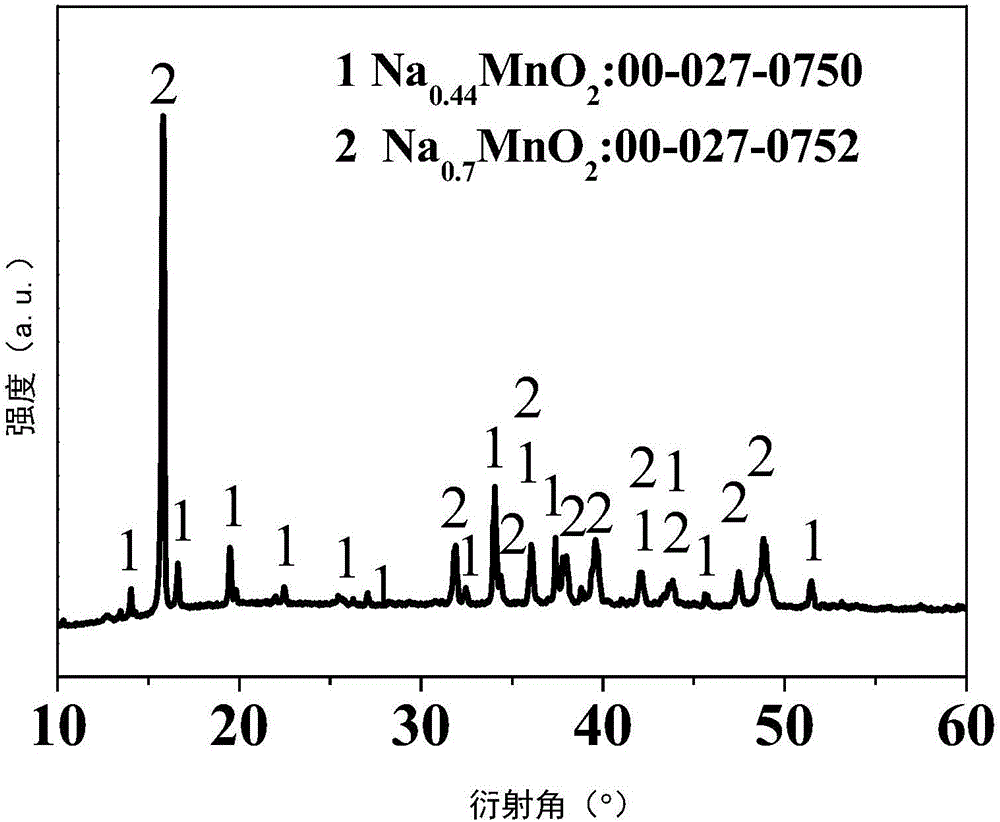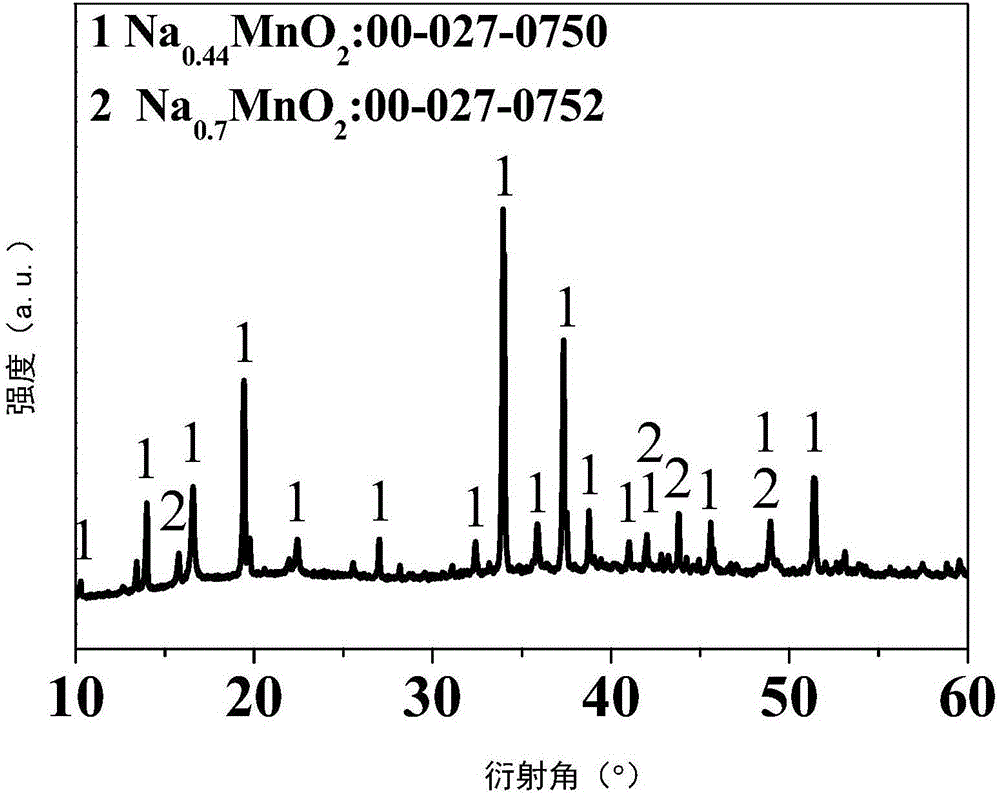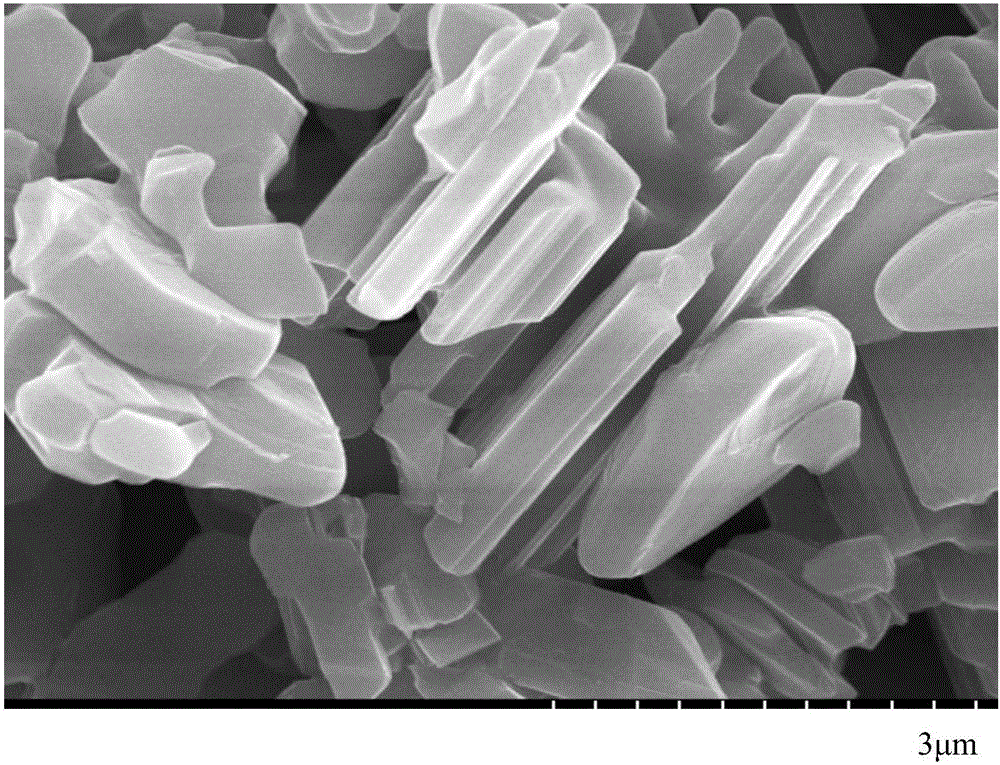Preparation method of sodium ion battery layered and tunnel composite structure manganese-based anode material
A sodium-ion battery and composite structure technology, applied in battery electrodes, secondary batteries, structural parts, etc., can solve the problems of positive electrode material cycle and poor rate performance, and achieve easy large-scale production, excellent cycle and rate performance, and process The effect of simple process
- Summary
- Abstract
- Description
- Claims
- Application Information
AI Technical Summary
Problems solved by technology
Method used
Image
Examples
Embodiment 1
[0033] Add 6.858 g of sodium acetate trihydrate and 19.607 g of manganese acetate tetrahydrate into 200 ml of deionized water to obtain solution A. 20.171g of oxalic acid was dissolved in 100ml of deionized water to obtain solution B. At room temperature, solution B was added dropwise to solution A while stirring, and stirred for 3 h after the reaction was completed. Then the obtained turbid solution was placed in a water bath at 80°C and stirred, and after all the solvent in the turbid solution was evaporated to dryness, it was transferred to an oven at 120°C for drying for 12 hours. Finally, the dried precursor is placed in a muffle furnace, pre-calcined at 450°C for 6h, then calcined at 800°C for 15h, with a heating rate of 5°C / min, and quenched with liquid nitrogen to obtain a layered-tunnel Composite structural manganese-based materials.
[0034] Add 25% conductive agent acetylene black to the synthesized material, 5% binder polyvinylidene fluoride (PVDF) to make a slur...
Embodiment 2
[0036] Add 5.71 g of sodium acetate hydrate and 19.607 g of manganese acetate tetrahydrate to 200 ml of deionized water to obtain solution A. 20.171g of oxalic acid was dissolved in 100ml of deionized water to obtain solution B. At room temperature, solution B was added dropwise to solution A while stirring, and stirred for 3 h after the reaction was completed. Then the obtained turbid solution was placed in a water bath at 80°C and stirred, and after all the solvent in the turbid solution was evaporated to dryness, it was transferred to an oven at 120°C for drying for 12 hours. Finally, the dried precursor is placed in a muffle furnace, pre-calcined at 450°C for 6h, then calcined at 800°C for 15h, with a heating rate of 5°C / min, and quenched with liquid nitrogen to obtain a layered-tunnel Composite structural manganese-based materials.
Embodiment 3
[0038] Add 6.287 g of sodium acetate hydrate and 19.607 g of manganese acetate tetrahydrate to 200 ml of deionized water to obtain solution A. 20.171g of oxalic acid was dissolved in 100ml of deionized water to obtain solution B. At room temperature, solution B was added dropwise to solution A while stirring, and stirred for 3 h after the reaction was completed. Then the obtained turbid solution was placed in a water bath at 80°C and stirred, and after all the solvent in the turbid solution was evaporated to dryness, it was transferred to an oven at 120°C for drying for 12 hours. Finally, the dried precursor is placed in a muffle furnace, pre-calcined at 450°C for 6h, then calcined at 800°C for 15h, with a heating rate of 5°C / min, and quenched with liquid nitrogen to obtain a layered-tunnel Composite structural manganese-based materials.
PUM
 Login to View More
Login to View More Abstract
Description
Claims
Application Information
 Login to View More
Login to View More - Generate Ideas
- Intellectual Property
- Life Sciences
- Materials
- Tech Scout
- Unparalleled Data Quality
- Higher Quality Content
- 60% Fewer Hallucinations
Browse by: Latest US Patents, China's latest patents, Technical Efficacy Thesaurus, Application Domain, Technology Topic, Popular Technical Reports.
© 2025 PatSnap. All rights reserved.Legal|Privacy policy|Modern Slavery Act Transparency Statement|Sitemap|About US| Contact US: help@patsnap.com



